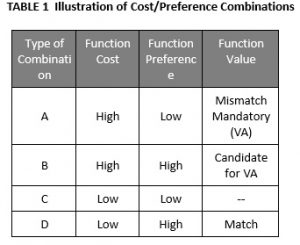By Muthiah Kasi, PE, SE, CVS-Life, FSAVE – Editor, Value World
Last week I received an email about the definition of Value. Author of the email is examining the definition Value = Function/Cost.
“In VE perspective value is defined as a fair return or equivalent in goods, services, or money for something exchanged that represented by Value = F/C, function what we get divided by cost/resource what we used to achieve that function.
He further questioned;
From the definition of Value = function/cost, how can we show to others that value is increased/decreased? We can say that if the function is kept to be the same while the cost is reduced, the value will increase. But how to show that? Sometimes, function is difficult to be measured not as easy as cost.”
Also the author of the email is comparing other techniques how value is achieved and compared. I would like to share my perspective that I have shared with the author of the email.
For each function, compare and tabulate the function preference to function cost Table 1 shows four possible combinations of cost/preference. If the cost of a function is high and the Customer thinks its importance is low, the result is a mismatch (Type A in Table 1). On the other hand, if the cost of a function is low and the Customer rates its importance as high, a high value is achieved and the Customer has a match (Type D in Table 1). These are the two extremes of the cost/preference measurement.
Use value analysis to propose and develop alternatives to reduce or eliminate Type A combinations. Employ value analysis to develop alternatives to reduce the cost of Type B combinations while maintaining high-preference functions. Maintain the Type D combinations since it is a match. Determine if the Type C combination with low cost is worth further analysis. Figure 1 illustrates graphically the concept as defined in Table 1.


For example, when the cost of a function is high and the need of the function is slightly more than average there are different techniques available to address the situation. The approach can be described in four possible scenarios. They are described as four zones.
Zone 1 and 1a are the result of Cost Reduction approach.
- Zone 1a: If they fall into Mismatch area they will be rejected. (Mismatch: Low performance at a high cost)
- Zone 1: A certain level of performance reduction at a cost savings may be accepted by owners.
- Zone 2: This belongs to cost improvement or efficiency techniques. This includes Lean Management, Lean Six Sigma etc…. This process may increase or slight decrease in performance at a reduced cost or effort. Owners accept the results when appropriate.
- Zone 3: If properly focused with function analysis, it opens the door to increased performance at a lower cost.
 What is discussed here is one person’s perspective. We would like to hear from you if you have a different perspective. Please email Melissa with your comments that will be worth publishing since the definition of Value is subjective.
What is discussed here is one person’s perspective. We would like to hear from you if you have a different perspective. Please email Melissa with your comments that will be worth publishing since the definition of Value is subjective.
